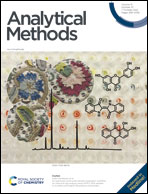Highly stable surface-enhanced Raman spectroscopy assay on abnormal thrombin levels in the blood plasma of cancer patients†
Abstract
The accurate discrimination of specific protein levels in the blood of cancer patients is of great importance in clinical diagnostics and prognosis. Here, we report a double-aptamer sandwich strategy on plasmonic magnetic beads (MBs) for a dual-reporter surface-enhanced Raman spectroscopy (SERS) assay for assessing abnormal thrombin (TB) levels in the blood plasma of cancer patients. This SERS assay demonstrated a linear analysis range of 20–400 pM in serum with a limit of detection as low as 20 pM, and to the best of our knowledge, this represents the first attempt to highly stably discriminate an abnormal TB level in the plasma of clinical cancer patients. Two recognition elements of TB aptamers provided high specificity and the dual-reporter assay demonstrated greatly reduced false-positive signals. The sandwich complex produced an efficient SERS “hot spot” to make up for the flaws of the insufficient enhancement of monomer metal nanoparticles. The plasmonic MBs enabled the direct tracking of ultratrace proteins in plasma while avoiding complicated pretreatment with only a few washing steps required. As a preliminary exploration, our report details a new potential tool with high sensitivity, selectivity, and practicality for disease-related protein testing in clinical diagnostics and prognosis.



 Please wait while we load your content...
Please wait while we load your content...